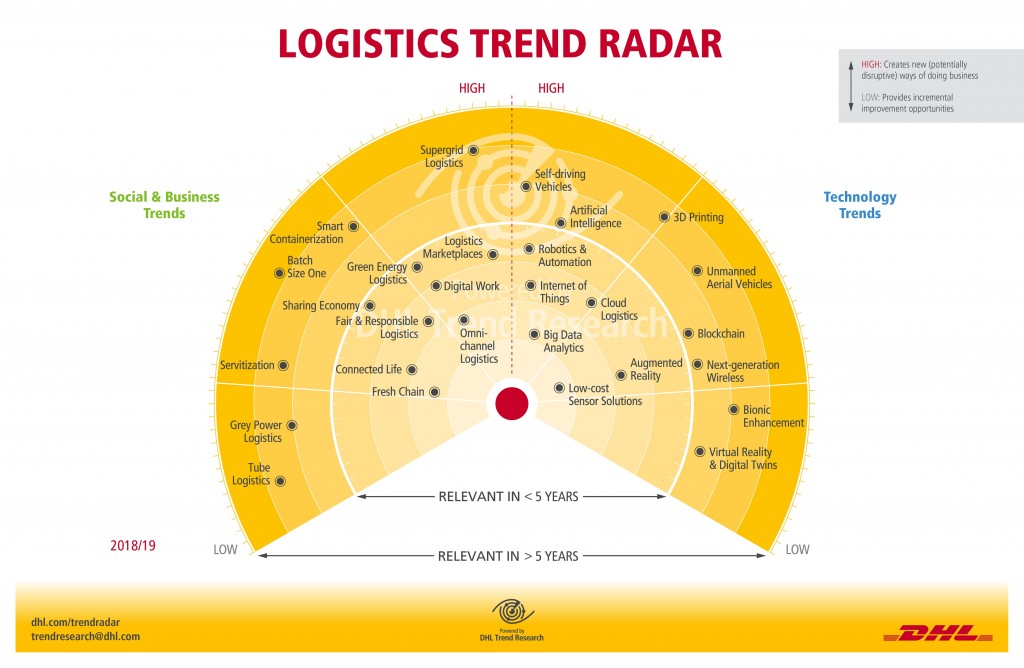The future of logistics depends on four key elements: customer-centricity, sustainability, technology and people’
New Logistics Trend Radar 2018/19 provides in-depth analysis of 28 significant social, business and technology trends transforming the future of logistics
Input from over 10,000 logistics professionals and technology experts was used to form new Logistics Trend Radar
Key trends cover Artificial Intelligence and Robotics; new trends include ‘Smart Containerization’ which highlights the need for new container formats to enhance urban logistics, and ‘Connected Life’ which is the integration of logistics services with smart home environments
In the fourth edition of the Logistics Trend Radar, a pioneering series that started in 2013, DHL reveals 28 key trends that could impact the logistics industry in the next five to ten years. The Logistics Trend Radar is developed through the analysis of mega- and microtrends as well as direct input from a large partner eco-system including research institutes, tech players, start-ups and customers. Most of the insights are collected first-hand from over 10,000 logistics professionals and technology experts who visit the DHL Innovation Centers annually. The findings are then aggregated and reflected on the Logistics Trend Radar which acts as a dynamic and strategic foresight tool that tracks the evolution of trends spotted in earlier editions and identifies promising new trends with every update.
Created by DHL Trend Research, the 2018/19 Logistics Trend Radar shows that innovation will be more important than ever, as digitalization drives the biggest transformation seen in the industry in coming years. “Our Logistics Trend Radar acts as a roadmap for innovation, helping to structure and catalyze further industry-leading research and projects together with our customers and partners. In this edition, we focus strongly on the digital revolution happening in the industry and its impact across four key elements defining the future of logistics: customer-centricity, sustainability, technology and people,” said Matthias Heutger, Senior Vice President, Global Head of Innovation & Commercial Development at DHL.
Customer centricity will be key to deliver on customer demands for a faster and more convenient logistics experience. An ever increasing amount of goods that can be purchased online – especially in the B2B market, is driving the need for B2B Omni-channel Logistics solutions. Customer demand is also driving growth in direct-to-consumer shipments of time-and-temperature sensitive goods. This Fresh Chain will require new innovations in packaging, storage and delivery of goods, such as groceries and pharmaceuticals. A key area for innovation in the last-mile will be the integration of logistics services into smart home environments captured as the trend of Connected Life.
Sustainability will become a mandate to operate in the logistics industry, as governments, cities and solution providers commit to sweeping agreements to cut down on CO2 emissions and waste. DHL for example, has committed to becoming emissions-free by 2050. Green Energy Logistics – the electrification of logistics fleets and facilities – provide huge potential for logistics to become more environmentally friendly. Smart Containerization in transportation will also be important in developing environmentally friendly formats for delivery in congested cities.
Technology will become widespread in logistics as the cost-performance-ratio tips for key trends such as Internet of Things and Artificial Intelligence in the next years. One trend that can accelerate this is the spread of next-generation wireless networks that can significantly increase the economics and value derived from connectivity in the supply chain. Another trend highlighted in this edition is blockchain where there has been a lot of hype and promise for the technology, but achieving industry buy-in may prove a significant hurdle to adoption.
People will continue to remain at the heart of logistics, even as the trend of robotics and automation as well as software automation will redefine the structure of the logistics workforce in the future. Highly repetitive, physically intensive tasks will be aided by technology, enabling people to do more meaningful tasks that require management, analysis and innovation. Digital work concepts will be required to attract and retain millennial talent in logistics as well as to support the existing, aging logistics workforce.
“As much as we aim for an accurate prediction, we know from experience that the impact of some trends will not materialize. Innovation does not follow a linear path – the success of some trends will rely on culture and capabilities as much it does on breakthrough technologies and business acumen. That’s why we need to actively engage first-hand on driving the development of these trends,” said Markus Kückelhaus, Vice President Innovation & Trend Research, DHL Customer Solutions & Innovation.
Transformative innovation projects from DHL are also highlighted in the report such as DHL’s development of electric cargo bikes for urban logistics, testing of smart locks that enable in-home delivery, and the use of artificial intelligence to predict global trade. Following this edition, DHL will initiate further deep dives on new trends to explore their implications in more detail.





